Nordic skiing is a fun winter sport that’s great for exploring snowy landscapes and staying active. But if you’re new to it, traditional long skis and specialized gear can feel overwhelming. That’s where Snowfeet* short skis come in - they’re compact, work with your regular winter boots, and are beginner-friendly. Here’s what you need to know:
- Snowfeet* are shorter (35 inches) than traditional skis (59–79 inches), making them easier to handle and store.
- They work with standard winter or snowboard boots - no need for expensive, specialized footwear.
- Perfect for various terrains: parks, hiking trails, or even your backyard after snowfall.
- Affordable and portable - they fit in a backpack and cost around $250–$275.
Whether you’re hitting groomed trails or creating your own path in the snow, Snowfeet* make Nordic skiing accessible and fun for everyone. Let’s dive into how they work, what gear you’ll need, and the best trails to try.
Must-Have Gear for Nordic Skiing
Snowfeet* NORDIC Cross-country Skate Skis: Your Compact Go-To
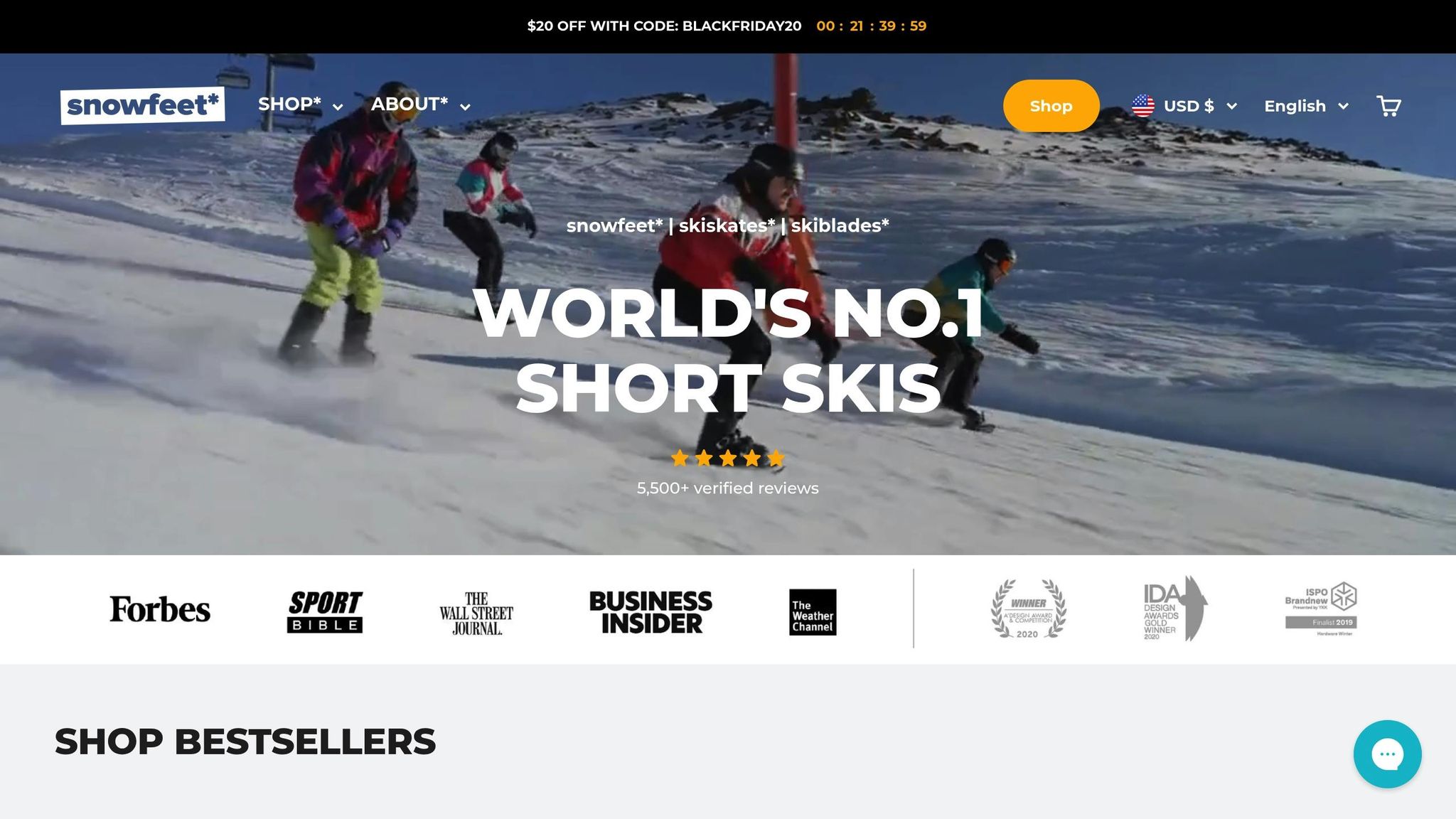
The Snowfeet* NORDIC Cross-country Skate Skis, measuring just 35 inches (90 cm), are a game-changer for Nordic skiing fans. These compact skis pack all the essentials for cross-country skiing into a lightweight, easy-to-handle design, skipping the bulk of traditional skis.
Here’s why they stand out: their size strikes a perfect balance between performance and portability. At half the length of standard Nordic skis (which are usually 59–79 inches), they’re easier to control and adapt to different terrains. This makes them especially handy for anyone who values agility and convenience.
Another bonus? Snowfeet* work with regular winter or snowboard boots - no need to invest in specialized footwear. Their lightweight build means you’ll spend less energy hauling them around and more time soaking in the snowy scenery.
For beginners, the shorter length offers quick responsiveness, making it easier to learn the basics without the awkwardness of traditional gear. That means more fun on the snow and less time wrestling with equipment. If you’re new to Nordic skiing or transitioning from standard setups, Snowfeet* are a great choice.
How Snowfeet* Compare to Traditional Nordic Skis and Snowboards
When you stack Snowfeet* against traditional Nordic skis or snowboards, they come out ahead in several key areas. Here’s a quick breakdown:
| Feature | Snowfeet* NORDIC (35") | Traditional Nordic Skis (59–79") | Snowboards |
|---|---|---|---|
| Portability | Super portable - fits in a backpack | Larger - often need roof racks | Bulky; storage can be tricky |
| Boot Requirement | Works with regular winter boots | Requires specialized boots | Requires specialized boots |
| Learning Curve | Easy to learn and master | Steeper learning curve | Moderate learning curve |
| Terrain Versatility | Great for parks, trails, and backyards | Best on groomed trails | Designed for slopes and parks |
| Maintenance | Low maintenance | Needs regular waxing and upkeep | Requires occasional adjustments |
Snowfeet* simplify your setup and cut down on the hassle. You won’t need extra storage solutions or expensive transport gear, making them a flexible and wallet-friendly option for winter fun.
Other Essentials for Your Nordic Skiing Setup
Once you’ve got your Snowfeet* NORDIC skis, a few extra pieces of gear can make your skiing adventure even better:
- Poles: These are key for balance and technique. Look for adjustable poles that reach up to your armpits when standing. Lightweight options like carbon fiber or aluminum work seamlessly with Snowfeet*. The shorter ski length also makes coordinating with poles easier.
- Winter Clothing: Layering is your best friend. Start with a moisture-wicking base layer, add an insulating mid-layer (think fleece or down), and finish with a windproof outer shell. Avoid cotton - it traps moisture and gets chilly fast. For your legs, thermal underwear and wind-resistant pants are a winning combo.
- Accessories: Don’t forget insulated gloves or mittens, a warm hat that covers your ears, and a neck gaiter to keep the cold at bay. On extra frigid days, throw in some hand and foot warmers for added comfort.
- Safety Items: A small backpack is handy for carrying extra layers, snacks, water, and a basic first aid kit. A whistle for emergencies is a smart addition, and always let someone know your route and expected return time before heading out.
With these essentials in hand, you’ll be ready to make the most of your Nordic skiing adventures. The right gear can make all the difference in keeping you comfortable, safe, and focused on the fun!
Cross-Country Skate Skiing for Beginners: Everything You Need to Know to Get Started || REI
How to Pick the Right Equipment
Choosing the right gear depends on your skill level, the terrain you’ll be tackling, and your goals. Luckily, Snowfeet* makes this process easier by offering versatile options that work well in various conditions and for different skill levels.
Take the 35-inch Snowfeet*, for example. These are designed to fit most adults without the hassle of matching ski lengths precisely. Unlike longer skis, they provide comfort and control across different terrains.
If groomed trails are your go-to, the Snowfeet* NORDIC Cross-country Skate Skis are a great choice. But if you’re looking to explore a mix of terrains - like park paths or hiking trails - the shorter, lightweight design of Snowfeet* offers flexibility and ease.
Your skiing style also plays a role. Whether you prefer a relaxed ride or sharp, aggressive turns, Snowfeet* strike a balance between stability and agility, something that’s harder to achieve with longer skis.
Now, let’s talk about getting the perfect fit.
Getting the Right Fit: Sizing and Boot Compatibility
One of the best things about Snowfeet* is how easy they are to pair with your existing boots. Unlike traditional Nordic setups that require specialized boots and bindings, Snowfeet* work with the winter, snowboard, or ski boots you probably already own.
For the best experience, choose boots with sturdy soles and solid ankle support. Mid-height or high-top boots provide better stability, while low-cut shoes or sneakers might not give you enough control on uneven snow. The adjustable bindings are designed to fit a wide range of boot sizes and can be set up in just a couple of minutes. After the initial setup, stepping in and out is a breeze - no tools required. It’s a far cry from the complex boot-binding systems of traditional Nordic gear.
Don’t forget to consider the weather when picking boots. Insulated boots are ideal for colder days (below 20°F), keeping your feet warm during longer outings. On milder days (above 32°F), lighter boots can offer more flexibility and comfort.
Once your gear fits perfectly, it’s worth comparing the benefits of owning Snowfeet* versus renting standard equipment.
Snowfeet* vs. Renting Standard Gear
When you compare the cost of Snowfeet* to renting traditional Nordic gear, the value becomes pretty clear. After just a few outings, rental fees can add up to the cost of owning your own Snowfeet*.
Beyond cost, there’s the consistency factor. Rental skis can vary in quality from one day to the next, which can be frustrating. With Snowfeet*, you get reliable performance every time, letting you focus on improving your skills instead of adjusting to unfamiliar gear. Plus, they’re super easy to transport - no bulky equipment to lug around.
Owning your Snowfeet* also means you can practice whenever and wherever you want, whether it’s at a local park or your favorite trail. Maintenance is simple too - just basic cleaning and the occasional strap replacement. Compare that to the waxing, edge tuning, and binding adjustments required for traditional skis, and it’s clear Snowfeet* are a low-maintenance, hassle-free option.
From fit to performance, Snowfeet* make Nordic skiing easier and more enjoyable.
Best Nordic Skiing Trails in the U.S.
The U.S. has plenty of beginner-friendly Nordic skiing spots, offering everything from groomed resort trails to snowy local parks. With their compact design and compatibility with standard winter boots, Snowfeet* make it even easier to explore these options.
Easy Nordic Ski Trails for Beginners
You don’t need to head to remote mountain ranges to dive into Nordic skiing. Across the U.S., you’ll find plenty of beginner-friendly terrain. Many ski resorts feature groomed cross-country trails and gentle green circle runs. These controlled, hard-packed surfaces are perfect for learning how to glide and practice basic turns, helping you build confidence as you go.
After a decent snowfall, flat open spaces like parks, golf courses, and recreation areas can also be transformed into great skiing spots. Snowfeet* are especially versatile here - you don’t need perfectly groomed trails. Just a few inches of packed snow is enough to get started.
State and national parks are another fantastic option. Many maintain winter trail systems that wind through picturesque forests and open meadows. These trails are often beginner-friendly, and Snowfeet* make navigating them even easier thanks to their shorter length compared to traditional skis.
Once you’ve mastered flat terrain, gently rolling hills are the next step. The lightweight design of Snowfeet* makes it easier to handle slight inclines, helping you tackle small elevation changes without feeling overwhelmed.
And the best part? Snowfeet* open the door to skiing in places you might not expect.
How Snowfeet* Opens Up More Trail Options
Snowfeet* don’t just make beginner trails more accessible - they also let you explore terrain that might be off-limits with traditional skis. Their compact 90-cm (35-inch) design is perfect for navigating tight spaces and unconventional spots.
For example, forest paths and hiking trails can turn into personal ski runs. Where longer skis might get tangled or stuck, Snowfeet* let you glide through narrow wooded trails with ease.
Even your own backyard or neighborhood can become a winter playground. After a snowfall, you can skip the long drive to a resort and practice on local hills, park paths, or even quiet streets. This convenience makes it easier to build your skills regularly.
Urban settings are fair game too. Snow-covered city parks, college campuses, and recreational areas become skiable terrain. Plus, Snowfeet* are incredibly portable. You can toss them in your car trunk or carry them on public transportation without the hassle of bulky equipment.
Whether it’s a local park or a snowy street, Snowfeet* work well on a variety of hard-packed snow conditions, giving you more chances to ski whenever and wherever the snow falls.
sbb-itb-17ade95
Learning Techniques and Staying Safe
Nordic skiing can feel like a breeze with Snowfeet*. Thanks to their compact design and thoughtful features, picking up the basics - whether you're into classic or skate skiing - becomes much simpler. Let’s explore how Snowfeet* makes learning easier while keeping safety front and center on every trail.
Basic Techniques Made Simple with Snowfeet*
Snowfeet*’s smart design takes a lot of the hassle out of mastering Nordic skiing techniques. At just 35 inches long, they give you natural control for both classic strides and skate skiing. Plus, the built-in heel brake system helps you quickly correct any slips or missteps, making the learning process way less frustrating.
Nordic skiing typically involves two main styles: classic and skate skiing. With Snowfeet*, these styles feel more approachable compared to traditional skis, which can stretch up to 7 feet and often feel bulky and hard to manage.
One of the standout benefits of Snowfeet* is how they provide immediate, precise feedback. If your stride is off or you lose balance, you can adjust quickly, giving you more confidence and helping you refine your technique without the steep learning curve of longer skis.
Safety Tips and Preparation
Staying safe on the trails is key. Start by dressing in layers that wick moisture, wear insulated gloves and hats, and carry an insulated water bottle to stay hydrated.
Snowfeet* come packed with safety features to help you stay in control. According to the Snowfeet Team:
"Both Snowfeet and Skiskates have metal edges, similar to traditional skis and snowboards, which is often a requirement at resorts. Metal edges allow you to grip the snow and control your speed, which is the main safety feature resorts look for. Both Skiskates and Snowfeet have sturdy and safety bindings that allow firm hold on your boots, so you are in complete control of your skis. Additionally, Snowfeet have a heel brake that allow you to slow down."
Before heading out, always check the weather and snow conditions. Avoid skiing during storms, when visibility is poor, or when temperatures dip below 0°F. While fresh powder might look inviting, packed snow is generally safer for beginners.
Good trail etiquette goes a long way, too. Stay in control, yield to faster skiers, and stick to designated trails. Snowfeet*’s compact design makes it easier to navigate crowded slopes and step aside when needed.
The Snowfeet Team also offers this advice:
"Stay in your comfort zone: Choose slopes and areas that match your skill level. Start with gentler runs until you are comfortable with Snowfeet* handling."
If you're planning to ski at a resort, it’s a good idea to double-check their policies:
"check resort policies: While most resorts allow Snowfeet*, it's advisable to check with the specific resort beforehand."
Learning Speed: Snowfeet* vs. Traditional Gear
Once you’ve nailed the safety basics, you’ll find that Snowfeet* can help you pick up skills faster than traditional Nordic skis. Why? Their design offers better maneuverability and more precise control over your speed.
Traditional Nordic skis, with their length, can feel clunky when navigating tight turns or trying to adjust your pace quickly. Snowfeet*, on the other hand, have a tighter turning radius and respond faster to your movements. This makes it easier to stay in control and build confidence, even on varied terrain.
Another bonus? Snowfeet* are super portable. You can practice almost anywhere - whether it’s the local park or your own neighborhood after a snowfall. This convenience means you’re more likely to practice regularly, and that’s the key to improving your skills in no time.
Why Snowfeet* Short Skis Beat Long Skis
When it comes to skiing, the old-school mindset says, "Longer skis mean better performance." Traditional Nordic skis can stretch up to 6 or 7 feet, but let’s be honest - lugging around something that long can be a pain, especially for beginners. Snowfeet* flips the script with their compact 35-inch design, making skiing more accessible, fun, and beginner-friendly. It’s a refreshing take that fits seamlessly into the modern approach to enjoying Nordic skiing.
Easy to Carry, More Freedom, and Tons of Fun
Let’s talk portability - this is where Snowfeet* really shines. Unlike traditional skis, which often demand roof racks, ski bags, and awkward door maneuvers, Snowfeet* can slide right into a regular backpack. Yep, they’re small enough to toss in your car trunk, carry on a plane, or easily store at home.
This portability means you’re no longer tied to groomed trails. Picture this: fresh snow in your local park, a dusting on a hiking trail, or even your backyard after a winter storm. Snowfeet* make it all fair game. They’re like the Swiss Army knife of winter sports gear - ready for anything.
Shorter skis also crank up the fun factor. Forget wrestling with long, clunky planks. Snowfeet* respond instantly to your movements, making tight turns and quick recoveries a breeze. This kind of agility boosts your confidence and lets you truly enjoy the ride.
Oh, and let’s not forget the cost savings. Traditional setups can set you back $400–$800 or more. Snowfeet*, on the other hand, cost about $250–$275, and you can use your regular winter boots - no need for pricey poles or specialized footwear. It’s skiing made simple.
What People Are Saying
Users rave about Snowfeet* for their versatility and how easy they are to learn. Many love the freedom they offer, letting you ski anywhere there’s snow - not just on designated trails.
Another big win? Learning speed. The compact design and responsive control help beginners pick up the basics much faster than with traditional skis. Even seasoned skiers enjoy experimenting with new moves that would feel risky or downright impossible on longer skis.
How Snowfeet* Stack Up Against the Competition
Here’s a quick look at how Snowfeet* compare to traditional Nordic skis and snowboards:
| Feature | Snowfeet* | Traditional Nordic Skis | Snowboards |
|---|---|---|---|
| Length | 35 inches | 72–84 inches | 48–65 inches |
| Transport | Fits in a backpack | Requires a roof rack or ski bag | Bulky; needs special transport |
| Boot Requirement | Regular winter shoes | Specialized Nordic boots ($150–300) | Snowboard boots ($200–400) |
| Skill Development | Immediate control; fast progress | Steep learning curve | Moderate to difficult |
| Terrain Versatility | Any snow-covered area | Typically groomed trails | Primarily resort slopes |
| Storage Space | Closet-friendly | Garage or basement required | Significant storage needed |
| Total Cost | $250–$275 | $400–$800+ (with boots and poles) | $500–$1,200+ (with boots and bindings) |
| Setup Time | 30 seconds | 5–10 minutes (with waxing/binding adjustments) | 2–3 minutes |
This table makes it clear: Snowfeet* aren’t just an alternative - they’re a game-changer. While big names like Burton, K2, and Atomic stick to refining traditional designs, Snowfeet* takes a different route, offering something simple, versatile, and, well, way more fun for all kinds of winter enthusiasts.
And the convenience doesn’t stop there. Traditional Nordic skiing often means planning your day around trail conditions, grooming schedules, and weather forecasts. Snowfeet*? They turn any snowy moment into an opportunity - whether it’s a quick lunchtime session or an impromptu adventure when fresh powder falls. Ready to make winter your playground? Snowfeet* might just be your perfect match.
Start Your Nordic Skiing Adventure with Snowfeet*
Nordic skiing doesn’t need to be complicated or overwhelming. Snowfeet* NORDIC Cross-country Skate Skis take a fresh approach to this winter sport, making it easy, enjoyable, and perfect for beginners.
Here’s why Snowfeet* stands out: simplicity. At just 90 cm (about 35 inches) long, these skis avoid the balance struggles that come with traditional longer skis. Instead, they give you a skating experience that's a lot like ice skating or rollerblading. Beginners can start by “skating like a hockey player” on flat, snowy terrain, making it an intuitive and fun way to hit the snow.
The universal bindings are another game-changer. They fit sizes 6–13 US / 38–47 EU and work with most winter or snowboard boots, so there’s no hassle with finding the right size or special footwear.
Portability? It’s a total win. Unlike traditional Nordic skis that need careful transport planning, Snowfeet* are small enough to fit in a backpack. This means you’re not tied to groomed trails - you can venture out and explore wherever the snow takes you.
Their lightweight design makes movement effortless, helping you build confidence and control without the steep learning curve of traditional skis. Plus, they’re budget-friendly, so you can jump into the action without breaking the bank.
Snowfeet* don’t replace traditional Nordic skiing - they complement it. You’ll still enjoy the cardio boost, the tranquility of snowy landscapes, and the thrill of gliding through fresh powder. But now, you’ve got gear that fits seamlessly into your lifestyle, making the experience more accessible and practical.
Ready to try? Grab your Snowfeet* and discover the freedom of skiing anywhere.
FAQs
Why are Snowfeet* short skis a better option for beginners compared to traditional Nordic skis?
Snowfeet* short skis bring a lot to the table for beginners. Their compact design makes them easy to handle and super maneuverable, which is a huge plus when you're just starting out. Unlike traditional Nordic skis, they don’t demand as much physical effort, giving new skiers a chance to build confidence without feeling overwhelmed.
Another big win? Snowfeet* short skis help with balance and stability, making the learning process smoother compared to longer skis. Plus, they’re lightweight and versatile, so you can explore different terrains without lugging around heavy gear. For anyone new to Nordic skiing, these features make Snowfeet* a fun and practical way to dive into the sport.
Are Snowfeet skis versatile enough for both groomed trails and off-trail skiing?
Snowfeet skis are built to handle a variety of terrains with ease. If you’re sticking to groomed trails or packed snow, the Snowfeet Mini Ski Skates (38 cm) are a great pick. They offer excellent control and are super easy to maneuver. Heading into mixed or deeper snow? The Snowfeet POWDER (99 cm) and Short Skis (120 cm) are designed to give you solid flotation and stability. For those who want a strong edge grip on firm snow but still need versatility in softer conditions, the Skiblades (65 cm and 99 cm) are a reliable choice.
Whether you’re cruising on well-maintained trails or diving into off-trail adventures, Snowfeet products are easy to use and a great alternative to traditional skis or snowboards.
What safety features make Snowfeet* a great choice for beginners in Nordic skiing?
Snowfeet* Skiblades are a great option for those new to Nordic skiing, thanks to their focus on safety. Their small size and lightweight build make them easy to control and more stable, which can help reduce the chances of falling. Compared to traditional skis or snowboards, they’re much simpler to handle.
To stay safe while using Snowfeet*, make sure your boots fit snugly, the bindings are fastened tightly, and the straps are in good shape. Beginners should stick to gentle, beginner-friendly slopes to get comfortable and practice the basics. And don’t skip the helmet - it’s an essential piece of gear to protect yourself out there.
With these safety features and a design that’s easy to use, Snowfeet* Skiblades are a solid choice for anyone wanting to ease into Nordic skiing with confidence.





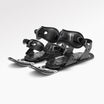

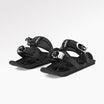
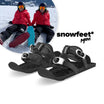

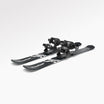

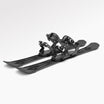
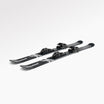
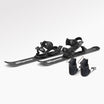







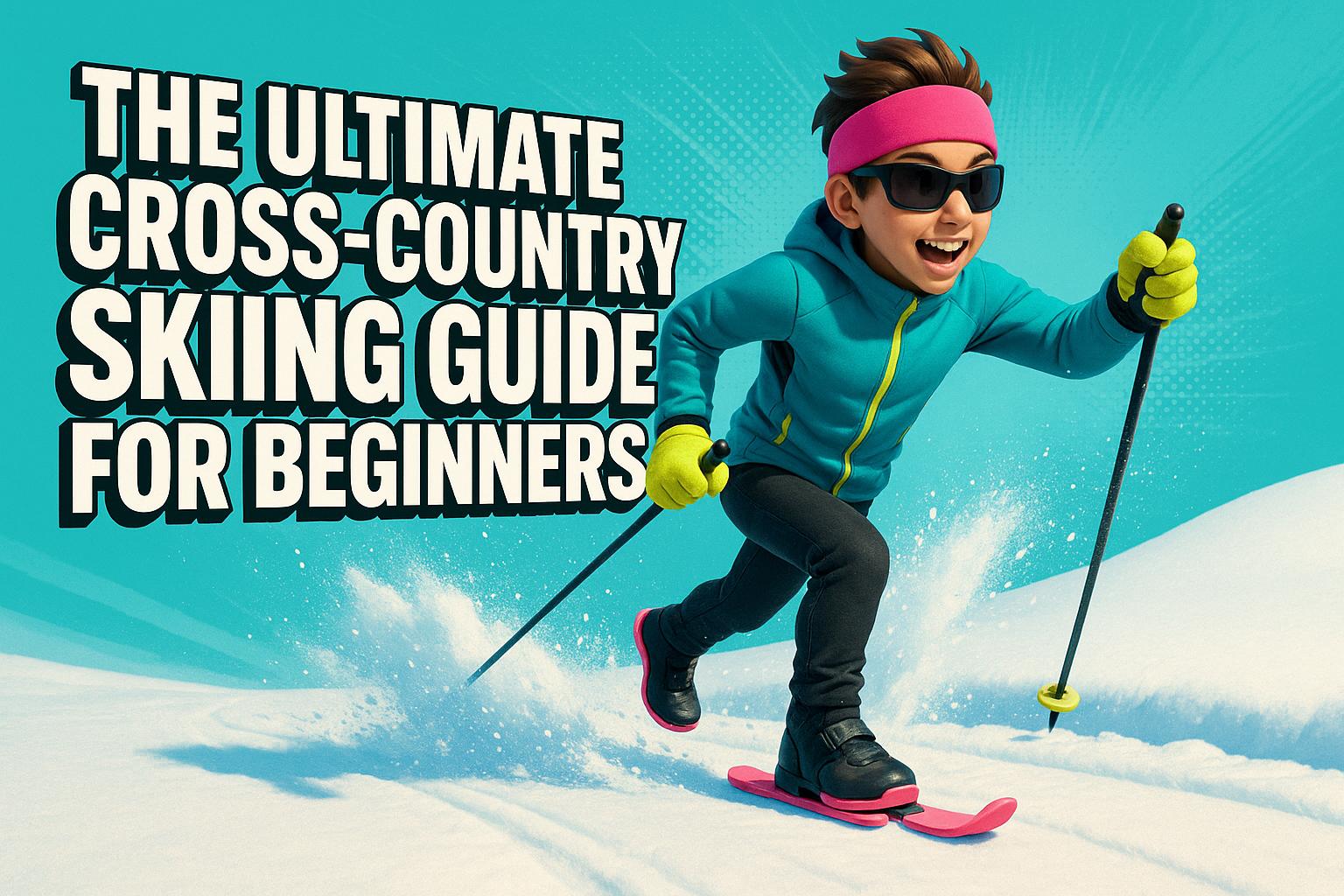
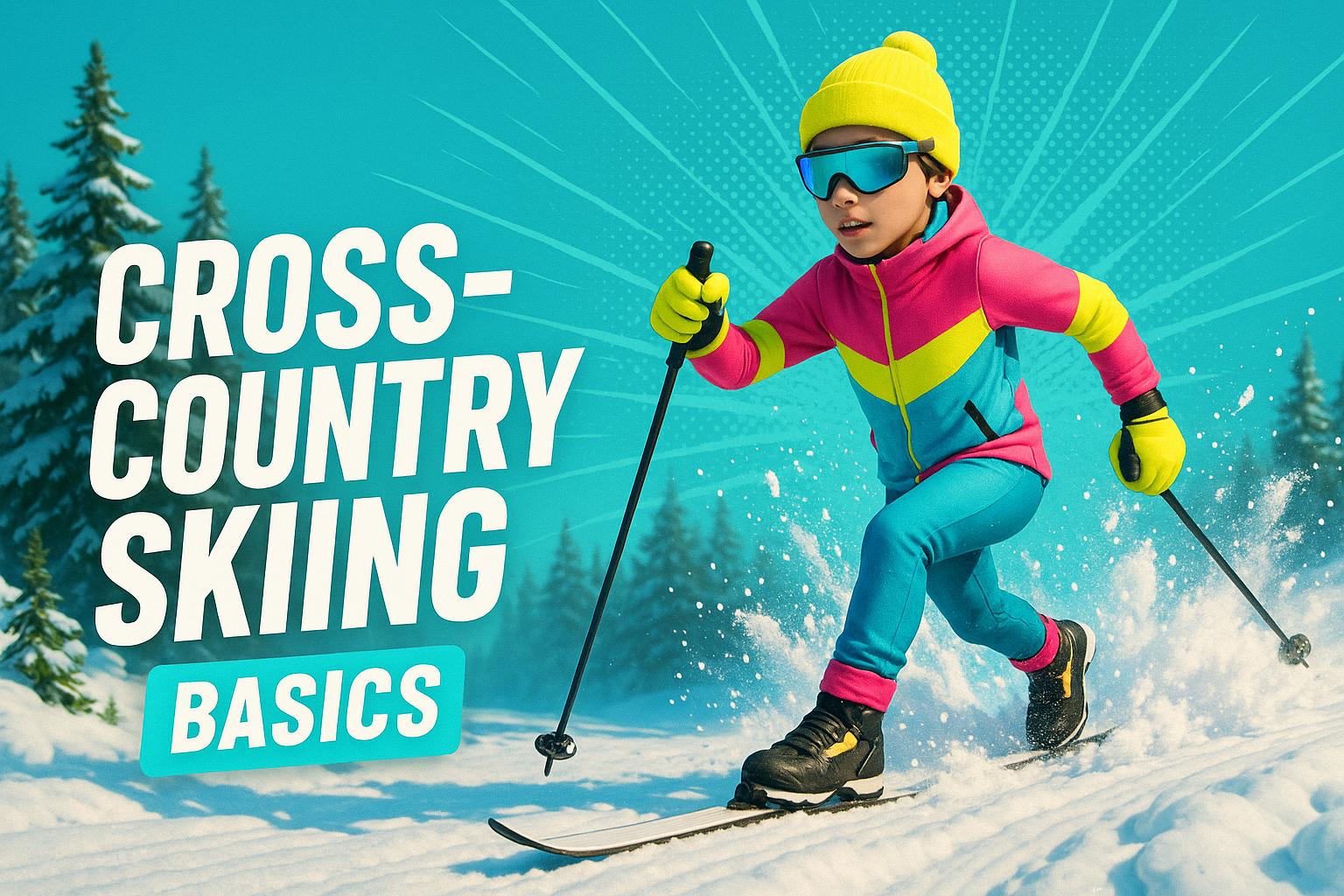
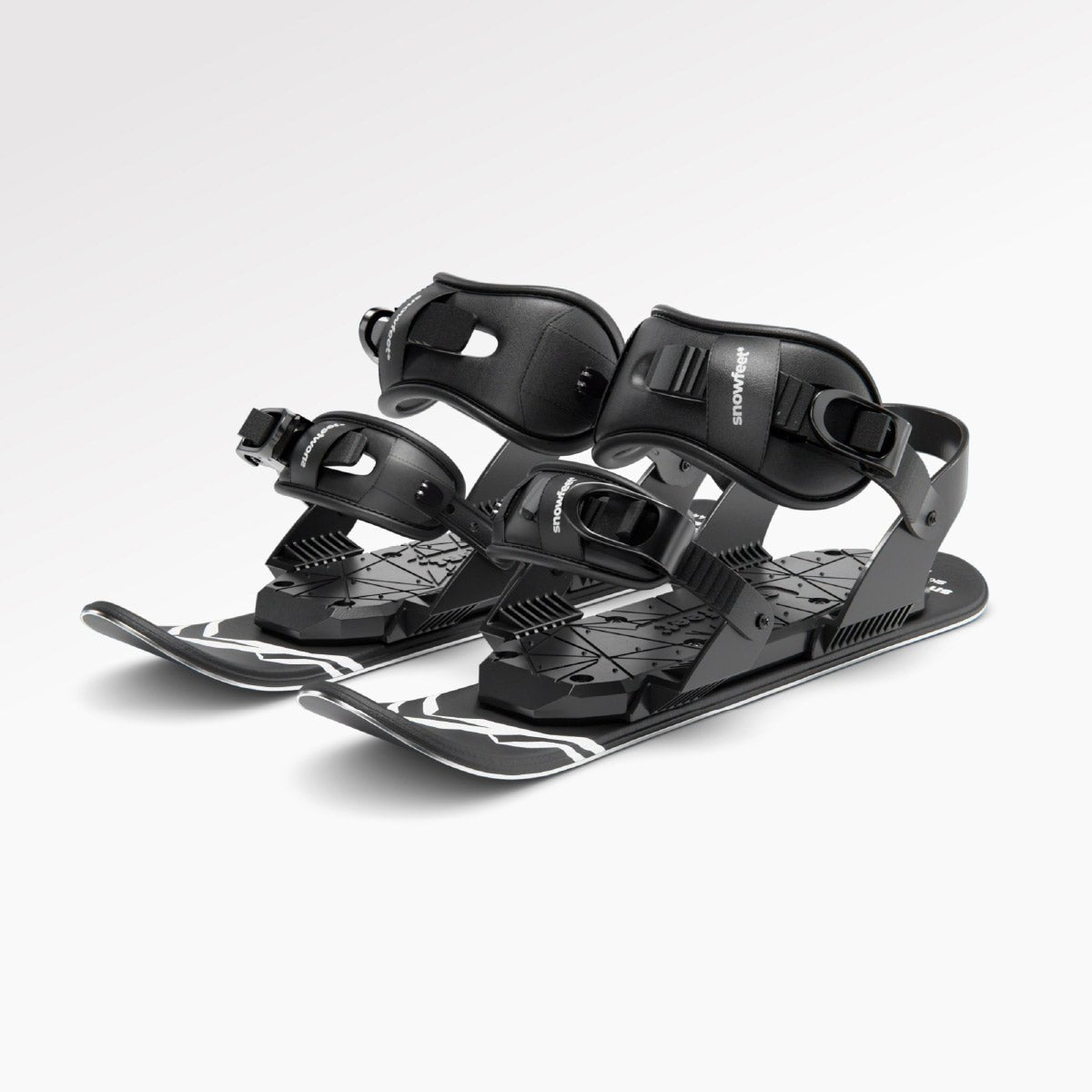

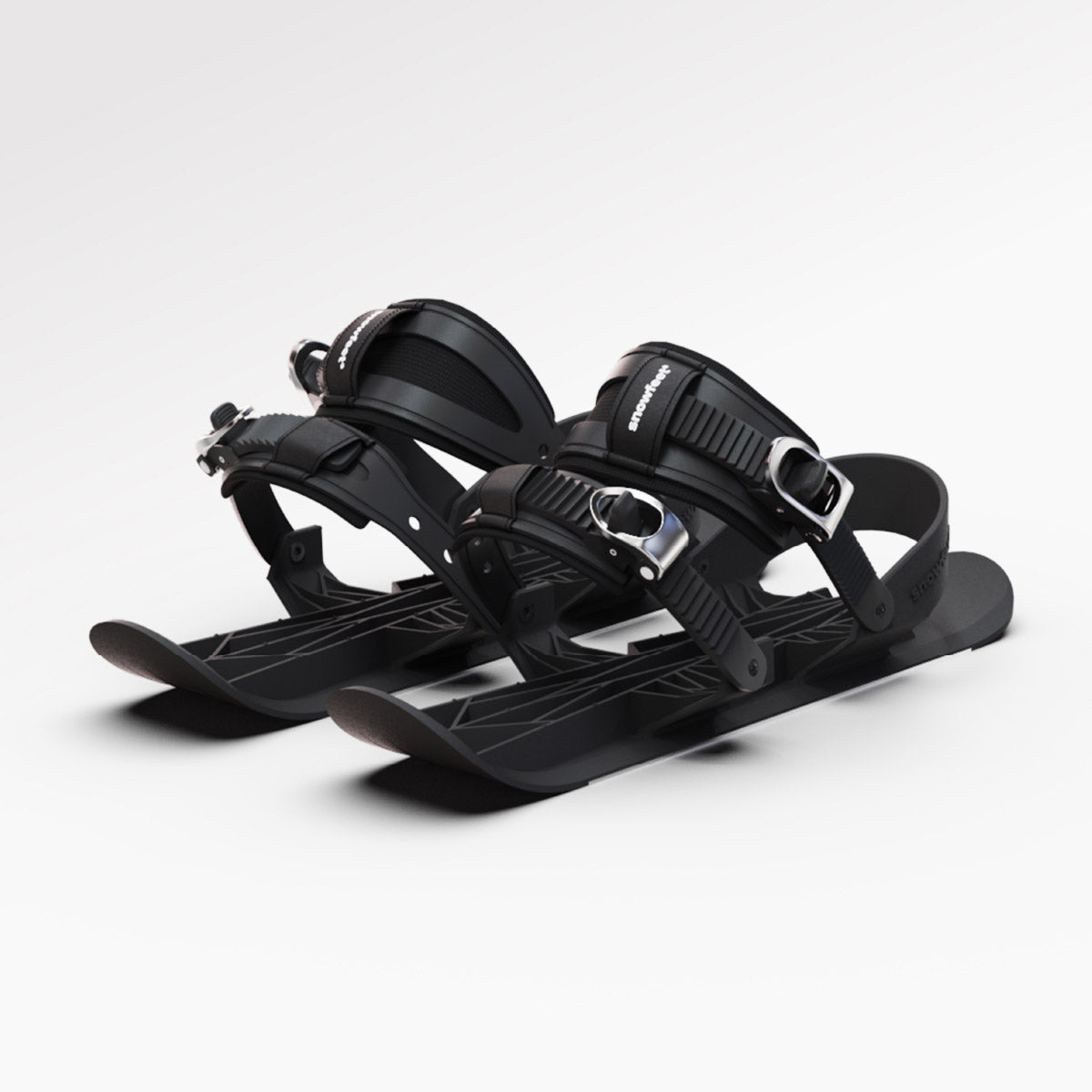

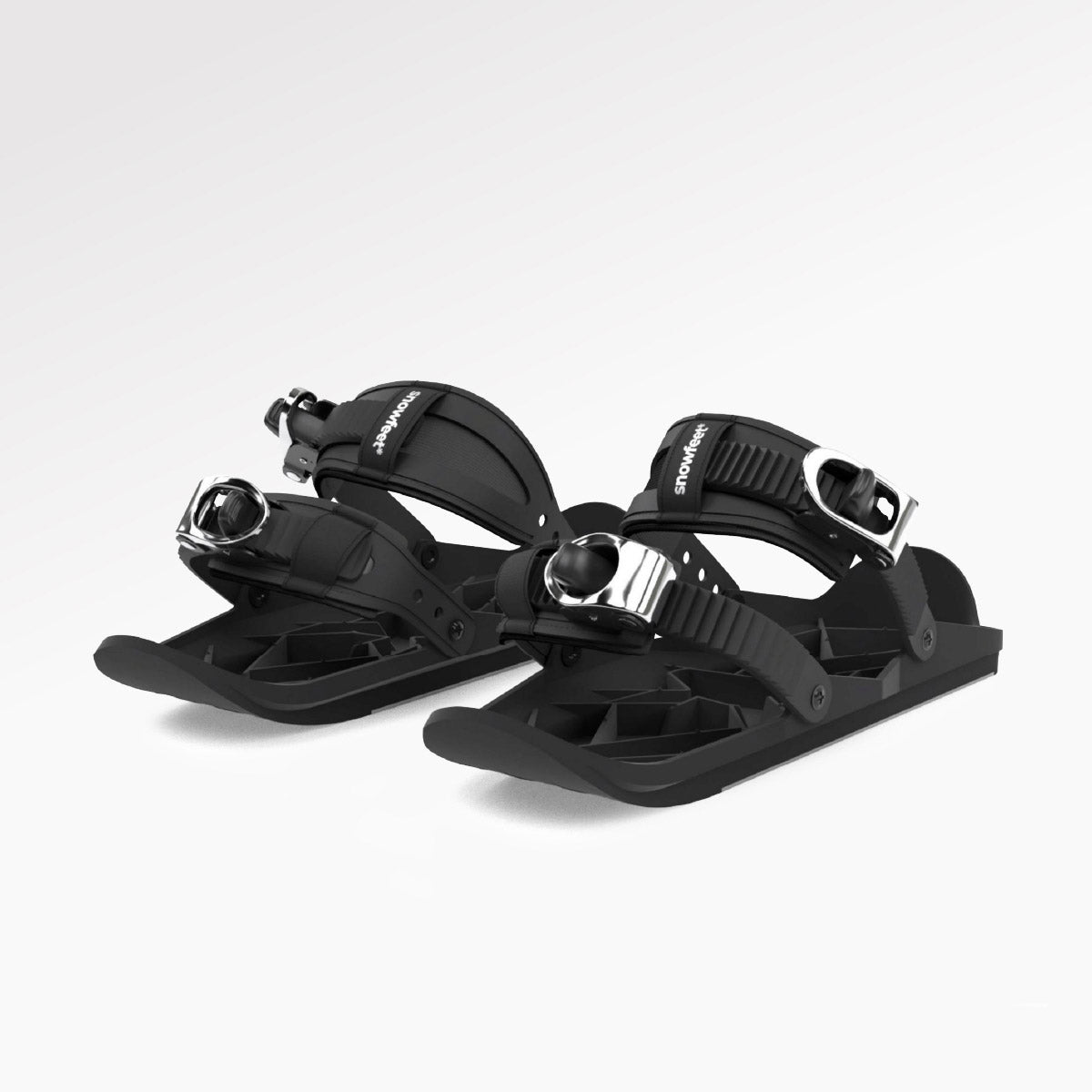



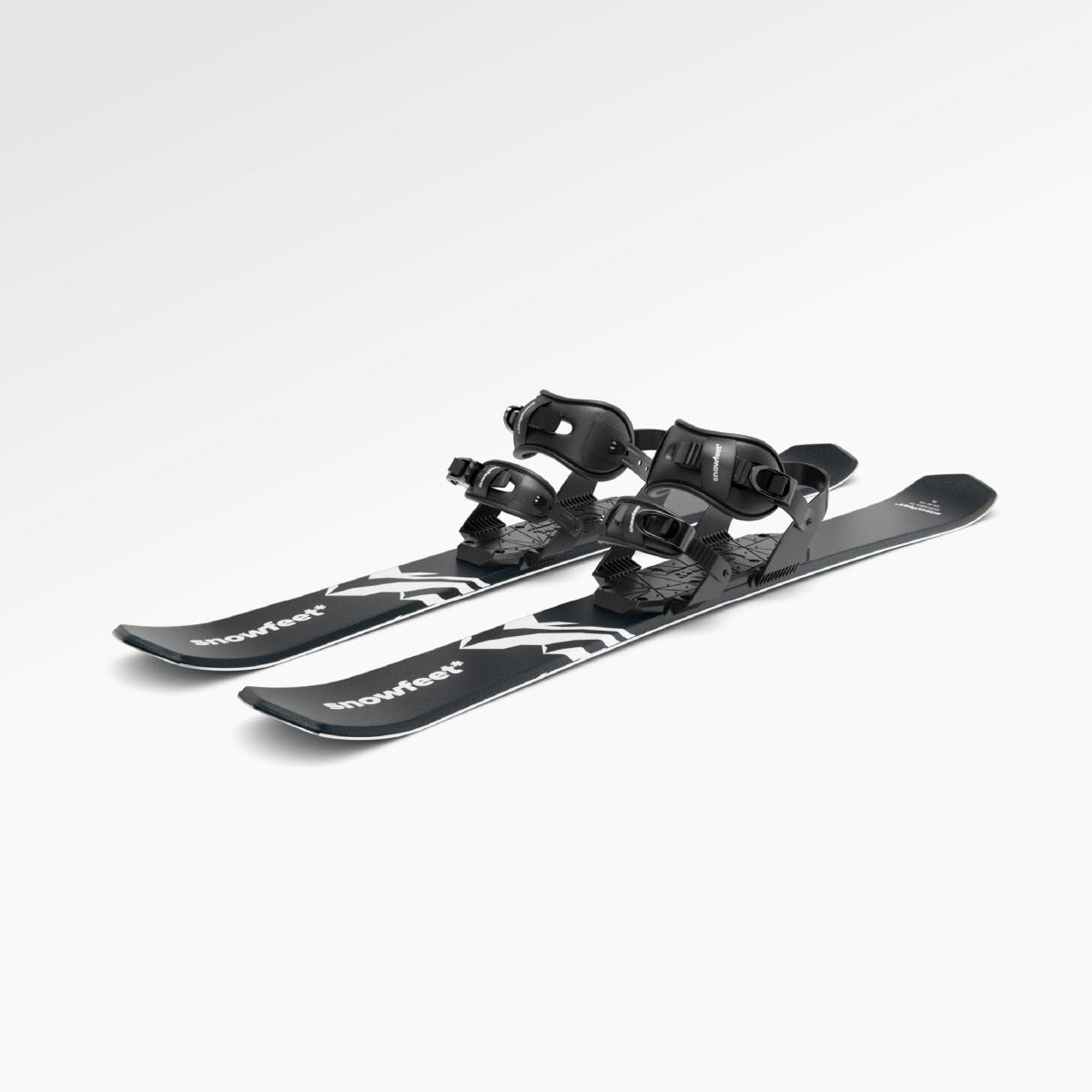

Laat een reactie achter
Deze site wordt beschermd door hCaptcha en het privacybeleid en de servicevoorwaarden van hCaptcha zijn van toepassing.